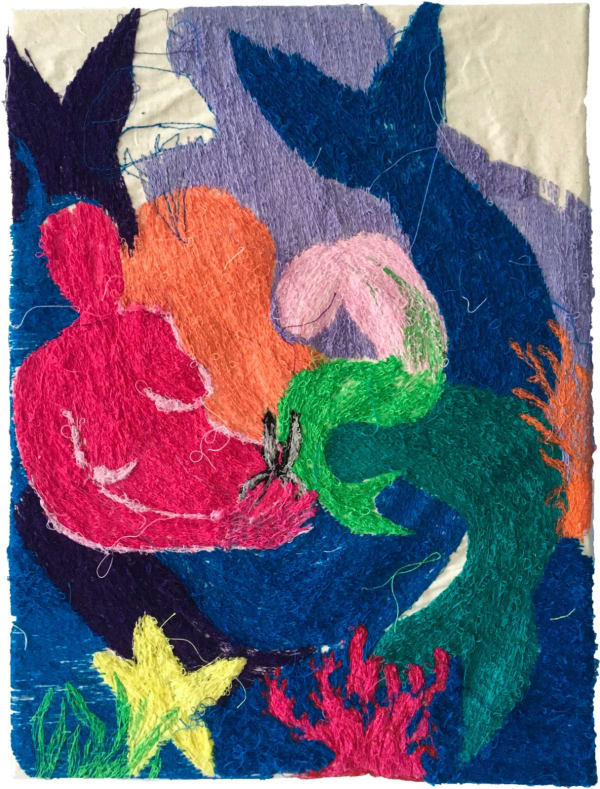Cheerleader for a funeral: Diana Matilda Crișan
We are pleased to invite you to the first solo show of Diana Matilda Crișan, Cheerleader for a funeral, curated by Valentina Iancu. The exhibition comprises a new body of works in which the artist weaves a feminine universe, where deep-seated taboos from our system of social norms are unraveled.
I felt alienated from everything around me, the language being spoken around me, the culture, life, even my own body. This alter ego is the personification of a woman responding to the oppression and persecution she has been subjected to, a rebellious, sexual woman that is always alone. - Diana Matilda Crișan
Diana Matilda Crișan
Cheerleader for a funeral*
curated by Valentina Iancu
Opening on Thursday, 17 February, 6 pm – 10 pm, with a live show by Chlorys.
17.02 – 14.04.2022
18 Dumbrava Roșie street, Bucharest
Diana Matilda Crișan weaves a feminine universe where deep-seated taboos from our system of social norms areunraveled. The balance between pathologized feminine sexuality and the sexualization of the feminine in connection to the demonic produces a transgression that playfully strengthens the statement that generated the most importantdiscussions around queer feminism from the second half of the 20th century to the present day: “one is not born, but rather becomes, a woman.” In her work The Second Sex, published in 1949, Simone de Beauvoir argues that biological, psychological, and intellectual differences are less defining of the idea of womanhood than the cultural constructs around gender roles. Theorists like Monique Witting, Judith Butler, and Sara Ahmed further nuanced this monumental observation in connection to sexual orientation, the performativity of gender, and the categories of class and race, respectively. Within this theoretical constellation, Matilda Crișan’s narratives escape from the construction of femininity as an “object” subordinated to society’s needs by a reproductive function into a universe freed from the prejudices of heteronormative hegemony. The artist sews bodies that return the gaze, that defy, have supernatural powers, play with fire, and celebrate their menstruation and, especially, their sexual pleasure. Thanks to the nature of her technique, there is a deeply ritualistic dimension to Crișan’s work, which strengthens the political position of her topics. Embroidery was reclaimed by feminist artists as a subversive means of expression linking the history of women who sewed isolated in the domestic space for centuries on end, without the right to autonomy, to current struggles for social equity. Through this medium, which has been undervalued throughout art history in com- parison to the “major arts” of patriarchal culture, generations of feminist artists all over the world chose to channel their own experiences into a language inspired by their deep understanding of the constructs governing femininity. Starting from her particular personal experience, Diana Matilda Crișan selects from the canonic iconography of feminine archetypes those symbols associated with autonomy and power: “I felt alienated from everything around me, the language being spoken around me, the culture, life, even my own body. This alter ego is the personification of a woman responding to the oppression and persecution she has been subjected to, a rebellious, sexual woman that is always alone.”
The exhibition “Cheerleader for a funeral” can be understood as an archive of feelings, emotions, and drives that are sowed, undone, and resowed in a compulsive rhythm: a cathartic path towards collective healing of the queer body. The representations of female sexuality embraced with a “radical softness” assumed as anti-normative and compassionately related to unfettered mythologies, create a space for reflection, interrogation, and acceptance. Queer sexuality is explored in absence, navigating through shame, taboos, and homophobic prejudice with a lack of knowledge. To experience a different kind of desire in an eminently hostile territory means the identification with a sinful, sick, criminal body. How do you negotiate with a rebel self, self-governed by a queer sexuality in a hetero- sexual world?
“Cheerleader for a funeral” is a space of mourning where human strength is revealed in its vulnerability. The queer surrender is a long process of unlearning and grief. Paraphrasing Simone de Beauvoir, Sara Ahmed notes that “we are not born, but rather become, heterosexual.” Identification guides orientation, creates language through self-rep-resentation. The works of Diana Matilda Crișan offer a common language for queer women, a necessary languagethat shatters a painful absence, creates a sense of belonging and a language that is all too necessary, for, as bellhooks noted: “What we cannot imagine, cannot come into being” (All About Love).
Valentina Iancu, curator
*“Cheerleader for a funeral” is a poem written by Nina Cassian in 1992.







































